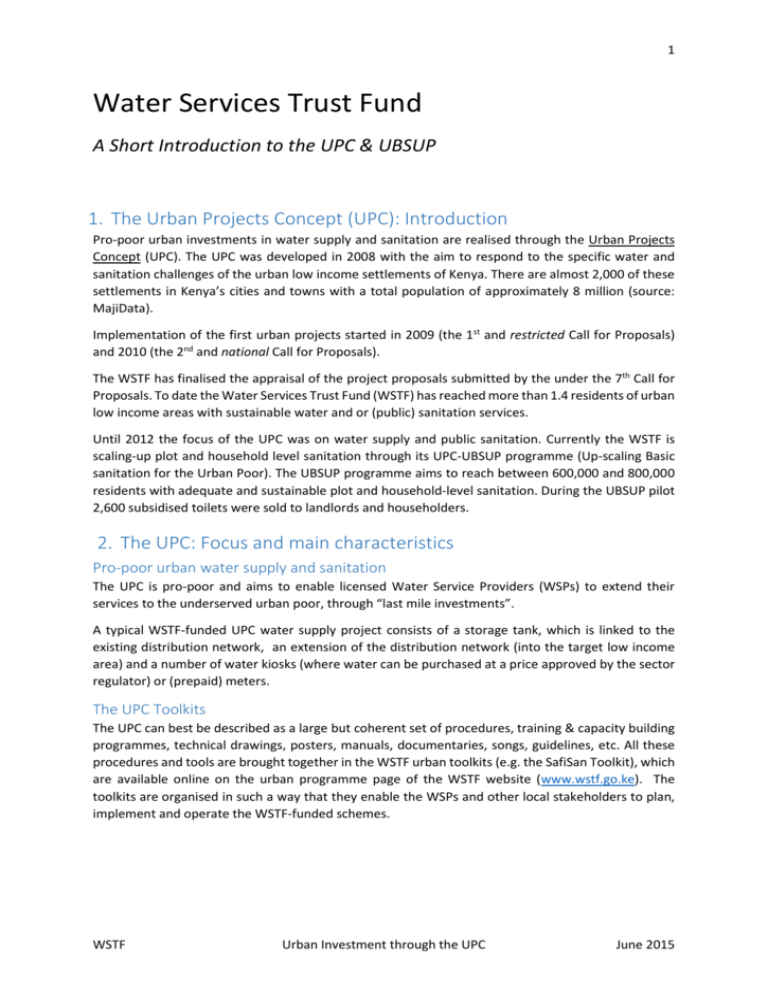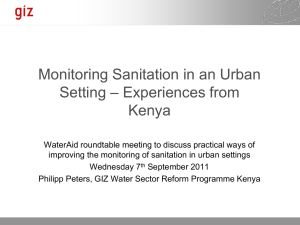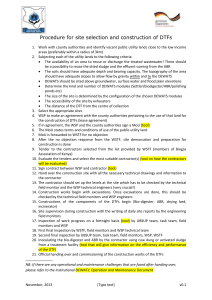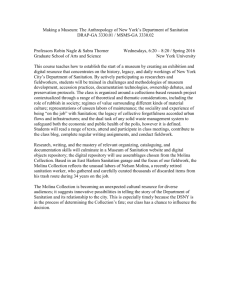3. Introduction to the UPC & UBSUP
advertisement

1 Water Services Trust Fund A Short Introduction to the UPC & UBSUP 1. The Urban Projects Concept (UPC): Introduction Pro-poor urban investments in water supply and sanitation are realised through the Urban Projects Concept (UPC). The UPC was developed in 2008 with the aim to respond to the specific water and sanitation challenges of the urban low income settlements of Kenya. There are almost 2,000 of these settlements in Kenya’s cities and towns with a total population of approximately 8 million (source: MajiData). Implementation of the first urban projects started in 2009 (the 1st and restricted Call for Proposals) and 2010 (the 2nd and national Call for Proposals). The WSTF has finalised the appraisal of the project proposals submitted by the under the 7th Call for Proposals. To date the Water Services Trust Fund (WSTF) has reached more than 1.4 residents of urban low income areas with sustainable water and or (public) sanitation services. Until 2012 the focus of the UPC was on water supply and public sanitation. Currently the WSTF is scaling-up plot and household level sanitation through its UPC-UBSUP programme (Up-scaling Basic sanitation for the Urban Poor). The UBSUP programme aims to reach between 600,000 and 800,000 residents with adequate and sustainable plot and household-level sanitation. During the UBSUP pilot 2,600 subsidised toilets were sold to landlords and householders. 2. The UPC: Focus and main characteristics Pro-poor urban water supply and sanitation The UPC is pro-poor and aims to enable licensed Water Service Providers (WSPs) to extend their services to the underserved urban poor, through “last mile investments”. A typical WSTF-funded UPC water supply project consists of a storage tank, which is linked to the existing distribution network, an extension of the distribution network (into the target low income area) and a number of water kiosks (where water can be purchased at a price approved by the sector regulator) or (prepaid) meters. The UPC Toolkits The UPC can best be described as a large but coherent set of procedures, training & capacity building programmes, technical drawings, posters, manuals, documentaries, songs, guidelines, etc. All these procedures and tools are brought together in the WSTF urban toolkits (e.g. the SafiSan Toolkit), which are available online on the urban programme page of the WSTF website (www.wstf.go.ke). The toolkits are organised in such a way that they enable the WSPs and other local stakeholders to plan, implement and operate the WSTF-funded schemes. WSTF Urban Investment through the UPC June 2015 2 Key UPC Procedures The UPC only works with licensed Water Service Providers (WSPs), Counties and Water Services Boards. The WSPs are the implementers and operation of the WSTF-funded water supply and sanitation projects. WSPs are also responsible for the preparation of project proposals that target the urban poor. Proposals can be prepared after the WSTF has launched a Call for Proposals in the national media. The UPC uses the following known procedure: 1. The launch of the Call for Proposals by the WSTF. 2. Data collection & proposal preparation (Using the Toolkits & the WSTF Procedures & Information Document). 3. Appraisal of the proposals & awarding (Involving: Management, Board of Trustees & Development Partners). 4. Project implementation (Using WSTF funds, Field Monitors, Project Task Team and Toolkit). 5. Project operation (Emphasis on sustainable operation, gender equality and customer care). 6. Project quality controls, (internal and external) audits & evaluation.1 Value for Money through Calls for Proposals Through the regular Calls for Proposals WSPs are given the opportunity to prepare project proposals for the urban low income areas within their Service Area. In order to be able to use reliable data on these areas the WSTF, at the request of the Ministry, has developed MajiData the online georeferenced database which contains detailed data on more than 2,000 low income areas. In addition to receiving proposals of better quality the WSTF is able to assess the potential impact of the proposed interventions (value for money). On average the WSTF receives between 100 and 190 project proposals (Funding Applications) per Call. 3. Forms of Support provided to the WSPs UPC: more than providing funds During the preparation of project proposals, the implementation and the operation of the urban projects the WSTF provides the following form of support: 1. Funding of awarded project proposals. 2. Direct support provided by the UPC team, the CEO & other WSTF staff members 3. Services of the WSTF County Resident Monitors (CRMs)2. 4. Regular (technical) workshops for Counties, Water Services Boards and WSPs. 5. Data & progress monitoring through MajiData3 which covers 1,964 areas. 6. Support to the Low Income units of WSP (a new activity). 7. Develop technical standards & coverage definitions (e.g. what is access to adequate sanitation). 8. Project implementation & operation approaches & procedures. 1 A major evaluation of the UPC will be carried out in July (funded by the German Government). The County Residents Monitors will replace the Field Monitors. Whereas the Field Monitors only worked for the urban programme of the WSTF the CRMs will also provide support to the rural and water resources projects funded by the WSTF. 3 Currently the MajiData updating concept is being developed by the WSTF, together with GIZ and WASREB the sector regulator. (www.MajiData.go.ke ) 2 WSTF Urban Investment through the UPC June 2015 3 9. Toolkits & the WSTF Procedures Document (Transparency). In other words, in addition to providing funds for pro-poor interventions, the Fund also provides capacity building, technical support and data. Since 2008 the WSTF has developed good and long-lasting working relationships with most licensed WSPs that go well beyond the duration of a single project (some WSPs are implementing their 6th UPC project). The WSTF has therefore, developed an important time-space advantage: Capacity building is done progressively, Call after Call. 4. This allows for the gradual phasing out of specific forms of support (i.e. the provision of office materials for WSP or the services provided by the CRMs). Interesting lessons learned with a specific project or WSP can be shared throughout the sector and with all WSPs. Value for Money through Operations Monitoring The sector and the Development Partners of the WSTF are not only interested in the successful planning and implementation of the projects but even more in the sustainable operation and maintenance of the installed infrastructure. In order to ensure that 90 – 95% of all infrastructure (with or without a user-interface) is operational at any time, the WSTF has developed an elaborate operations monitoring concept. The operations monitoring exercise is carried out once a year (the 2nd exercise is planned for July this year) and remedial measures are foreseen to ensure that nonoperational infrastructure is repaired and/or operated. WSPs with a poor operational track records do not receive any additional funding. The data collected with WSTF mobile (Android) application is georeferenced put online in order to ensure full transparency (data sets data includes geo-referenced pictures of all infrastructure). Value for money though technical standards and innovative solutions In order to ensure that all infrastructure with a user interface (e.g. water kiosks, prepaid meters, public sanitation facilities and household-level latrines) are safe user-friendly and easy to (keep) clean, the WSTF has developed a number of technical standards (technical drawings, bills of quantities, etc.) for the Kenyan Sector. Using the CuAd (Customer-Aided Design) approach these standards were designed together with users and with women in particular. 4. The UPC : programmes Within the UPC a distinction can be made between the urban water supply and public sanitation projects on the one hand and the plot and household sanitation projects (SafiSan Projects which are part of the UBSUP programme). Whereas the demand for safe water and public sanitation services only becomes apparent after project commissioning, the demand for improved SafiSan toilets occurs during the project. SafiSan projects are demand driven and during implementation the sale of subsidised toilets is promoted using a set of social marketing techniques. The UBSUP programme has a sanitation value chain emphasis. This means the SafiSan projects not only focus on the sale of improved toilets (e.g. UDDTs5) but equally on toilet emptying, sludge transportation and (decentralised) treatment. 4 5 Some WSPs were only established in 2008. UDDT = Urine Diversion Dry Toilet. WSTF Urban Investment through the UPC June 2015 4 Focus on adapted solutions and innovation In order to enable the WSP to provide better and more sustainable services, the WSTF has developed a significant number of new designs and innovations such as: The user-friendly water kiosk. A redesigned prepaid yard tap. An improved public sanitation facility. An Android application for project progress reporting. An Android application for operations monitoring (being finalised). The SaniGo cart for toilet emptiers. Step-by-step construction handbooks for Contractors. Definitions of access and coverage for water supply and sanitation. 5. The UPC: Key partners The Urban Programme has a number of partners supporting its operations including development partners and the implementing partners. WSPs are the principal implementers of Urban projects. The programme has been supported by the following key development partners: European Union; German Development Bank (KfW); Bill and Melinda Gates Foundation (BMGF); The World Bank; Google and Un-Habitat. 6. The UPC: Impact WSTF through its urban window has invested a total of KES 2.5 billion (USD 26 million) which have benefitted about 1.39 million people with access to improved water supply and basic sanitation. The achievements have been guided by the following 1. Pro-poor targeting of financing for water supply and sanitation through calls for proposals by legible water service providers (WSPs) where WSTF have been able to extend water supply and sanitation to several urban low income areas. The interventions have been through financing of water supply extension, construction of public sanitation facilities and subsidizing of household and plot level sanitation. 2. Market-based WASH service delivery models scaled up in which WSTF recognizes the fact that markets are efficient mechanisms for allocating resources between those that have them and those that want them. WSTF has emerged as a key promoter of market based approaches in water supply and sanitation through the development of market based concepts in urban sanitation and water supply, piloting of these concepts and up-scaling the approaches. An example is Up-Scaling Basic Sanitation for the Urban Poor (UBSUP) over 30,000 beneficiaries reached with 3 pilots in 3 WSPs through subsidized toilets targeting appropriate technologies, sanitation marketing and analysis of sanitation value chain revenue streams for different stakeholders. 3. Provision of access to financing / credit for WASH services through commercial financing as part of the building resilience pillar of WSTF’s pro-poor development work and in efforts to complement longer-term WASH development objectives and maximise opportunities to deliver sustainable results. Under this programme, water utilities implement projects pre-financed through loans from local commercial banks. On attainment of agreed deliverables, WSTF provides a subsidy of between 40 and 60% of project cost. WSTF has recently piloted these result based financing approaches and through the first pilot in Embu water company have reached over 50,000 people. WSTF Urban Investment through the UPC June 2015







